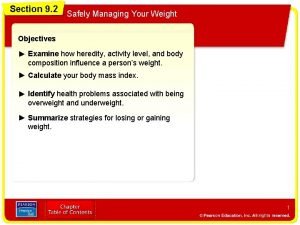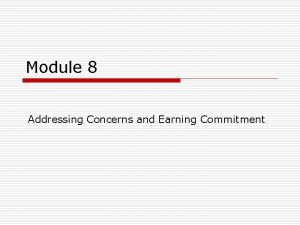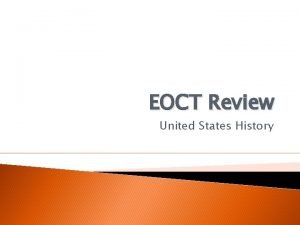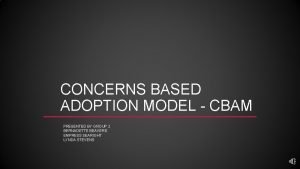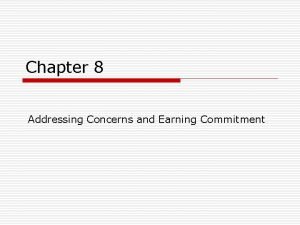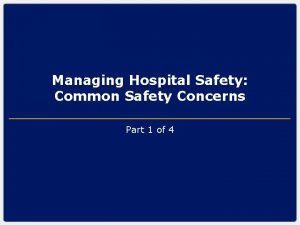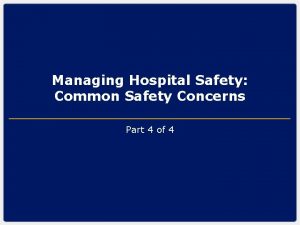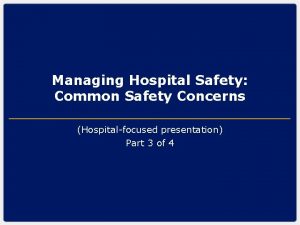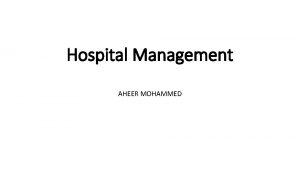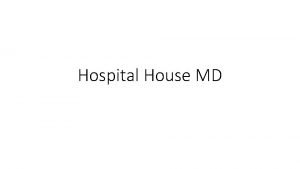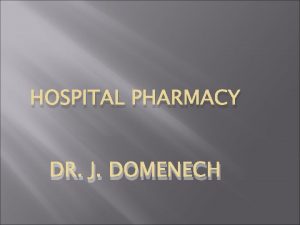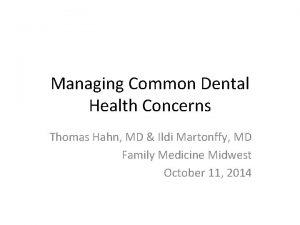Managing Hospital Safety Common Safety Concerns Part 2













- Slides: 13

Managing Hospital Safety: Common Safety Concerns (Part 2 of 4)

Needlestick Injuries Are Common and Can Be Avoided • Needlestick injuries are frequently underreported 1 Top 3 times when needlestick injuries occur 1: 1. While giving an injection 2. Before activating the safety feature 3. During disposal of a nonsafety device More than 80% of needlestick injuries could be avoided with the use of safer needle devices 2 1. American Nurses Association. 2008 study of nurses’ views on workplace safety and needlestick injuries. http: //www. nursingworld. org/Main. Menu. Categories/Occupationaland. Environmental/occupationalhealth/Safe. Needles/2008 Inviro Study. aspx. Accessed January 29, 2009. 2. American Nurses Association. Needlestick prevention guide. http: //nursingworld. org/Main. Menu. Categories/Occupationaland. Environmental/occupationalhealth/Safe. Needles/Needlestick. Preve ntion. aspx. Accessed January 29, 2009.

Implement Practices to Help Avoid Needlestick Injury • Use prefilled medication devices 1 • Train health care workers on proper administration and disposal techniques 2 • Utilize sharps with engineered sharps injury protection 1, 2 • Document sharps-related injuries 1 • Encourage nonpunitive, convenient reporting of needlestick injuries 3 • Evaluate and select safety-engineered devices based on caretaker preference 2 1. National Institute for Occupational Safety and Health. Preventing needlestick injuries in health care settings. November 1999. http: //www. cdc. gov/NIOSH/pdfs/2000 -108. pdf. Accessed January 29, 2009. 2. Occupational Safety and Health Administration. OSHA fact sheet: bloodborne pathogens. http: //www. osha. gov/Osh. Doc/data_Bloodborne. Facts/bbfact 01. pdf. Accessed January 29, 2009. 3. American Nurses Association. 2008 study of nurses’ views on workplace safety and needlestick injuries. http: //www. nursingworld. org/Main. Menu. Categories/Occupationaland. Environmental/occupationalhealth/Safe. Needles/2008 Inviro. Study. aspx. Accessed January 29, 2009.

“Never” Events • Serious, identifiable, and preventable medical errors leading to unfavorable consequences • The policies and procedures of health care organizations considerably impact the risk of occurrence of “never” events National Quality Forum. Serious Reportable Events in Healthcare, 2006 Update: Executive Summary. Washington, DC: NQF; 2007.

Categories of “Never” Events • Surgical – Amputation of incorrect body part • Product/device – Use of contaminated device • Patient protection – Inability to prevent a patient suicide • Care management – Medication error leading to hypoglycemic event • Environmental – Patient fall during hospital stay • Criminal – Impersonation of a health care provider National Quality Forum. Serious Reportable Events in Healthcare, 2006 Update: Executive Summary. Washington, DC: NQF; 2007.

Hospital-Acquired Conditions: “Reasonably Preventable” Events Foreign object left in patient postsurgery Air embolism Blood incompatibility Falls and trauma Pressure ulcers Vascular catheter-related infection Catheter-related urinary tract infection Manifestations of poor glycemic control Certain orthopedic surgical site infections Surgical site infectionmediastinitis following CABG Bariatric surgical site infections Deep vein thrombosis or pulmonary embolism after orthopedic procedures Department of Health and Human Services: Centers for Medicare and Medicaid Services. Fed Regist. 2008; 73: 48433 -49084.

CMS Moves Aggressively to Encourage Greater Patient Safety in Hospitals • The following selected conditions were added to the list of hospital-acquired conditions on August 19, 2008: – Surgical site infections following specific procedures, including certain orthopedic surgeries, and bariatric surgery for obesity – Certain manifestations of poor control of blood sugar levels – Deep vein thrombosis or pulmonary embolism following total knee replacement and hip replacement procedures CMS = Centers for Medicare and Medicaid Services. Department of Health and Human Services. Centers for Medicare and Medicaid Services. Fed Regist. 2008; 73: 48433 -49084.

Medicare/Medicaid Cease to Reimburse for Preventable Complications • For discharges occurring on or after October 1, 2008, hospitals will not receive additional payment for cases in which 1 of the selected conditions is not present on admission 1 Foreign object left in patient postsurgery Air embolism Blood incompatibility Falls and trauma Pressure ulcers Vascular catheter-related infection Catheter-related urinary tract infection Manifestations of poor glycemic control Certain orthopedic surgical site infections Surgical site infection-mediastinitis following CABG Bariatric surgical site infections Deep vein thrombosis or pulmonary embolism after orthopedic procedures • New York and Massachusetts have further limited Medicaid reimbursement of complications due to medication errors 2 1. Department of Health and Human Services. Centers for Medicare and Medicaid Services. Fed Regist. 2008; 73: 48433 -49084. 2. National Conference of State Legislatures. "Never Events" become ever present as more states refuse to pay for mistakes. July 2008. http: //www. ncsl. org/programs/health/shn/2008/sn 519 b. htm. Accessed January 29, 2009.

Who Is Responsible for Maintaining Hospital Safety?

Health Care Team Must Work Together to Provide a Safe Atmosphere • Physicians, pharmacists, nurses and support staff must work collectively to provide a safe atmosphere for patients 1 • A safety officer is often assigned to implement and enforce safety practices within the hospital 2 • Most medication errors are not a direct result of one causative factor or individual 3 • Errors are generally caused by a flawed system, or lack of structured practices 4 1. Hellman R. Endocr Pract. 2006; 12(suppl 3): 49 -55. 2. Institute for Healthcare Improvement. Develop a culture of safety: designate a patient safety officer. http: //www. ihi. org/IHI/Topics/Patient. Safety/Safety. General/Changes/Individual. Changes/Designate%20 a%20 Patient%20 Safety %20 Officer. Accessed January 29, 2009. 3. Institute of Medicine. To err is human: building a safer health system. November 1999. http: //www. iom. edu/Object. File/Master/4/117/To. Err-8 pager. pdf. Accessed January 29, 2009. 4. Hellman R. Endocr Pract. 2004; 10(suppl 2): 100 -108.

Culture of Safety Can Improve Patient Outcomes Defective culture No barriers Unintended injury Scope of awareness Initial physician orders Intended therapeutic result TIME Nurse and pharmacist on team Backup check by peer No injury Adapted from Hellman R. Endocr Pract. 2004; 10(suppl 2): 100 -108. Correctio n by physician “Culture of safety”

Major Safety Organizations Strive to Improve Patient Safety • The Joint Commission on the Accreditation of Healthcare Organizations (JCAHO) • Institute for Safe Medication Practices (ISMP) • Institute for Healthcare Improvement (IHI) • Occupational Safety and Health Administration (OSHA) • Centers for Medicare and Medicaid Services (CMS)

Points to Consider • What best practices does your hospital follow to promote patient safety? • In light of CMS’s initiative to not reimburse for preventable complications, what protocols are being implemented in your hospital? • How can you raise awareness about medication errors and improve communication with your health care team?
 Hospital pharmacy
Hospital pharmacy Managing your weight part 2
Managing your weight part 2 Cross-cutting concerns
Cross-cutting concerns Software design separation of concerns
Software design separation of concerns Network layer is concerned with
Network layer is concerned with Addressing concerns and earning commitment
Addressing concerns and earning commitment What happened in 1777
What happened in 1777 Product +concerns
Product +concerns Cbam levels of use
Cbam levels of use Spirit airlines corporate social responsibility
Spirit airlines corporate social responsibility Addressing concerns and earning commitment
Addressing concerns and earning commitment Joys and concerns images
Joys and concerns images Joys and concerns prayer
Joys and concerns prayer Ddd cross cutting concerns
Ddd cross cutting concerns

